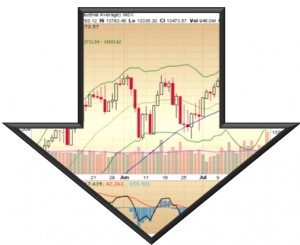 When it comes to investing in markets, there are long-term and short-term approaches.
When it comes to investing in markets, there are long-term and short-term approaches.Long term investing is typically defined as investing for 5 years or longer and investors (try to) ignore the ups and downs of the markets believing that over time the values of their investments will trend upwards.
Short term investing is much more fast paced and rather than ignoring the ups and downs, known as volatility, investors attempt to profit from the fluctations.
Both types of investors attempt to follow the adage ‘Buy low, sell high’, but the timelines are vastly different.
Investors hoping to profit from the rise and fall of markets often make a lot of frequent trades and therefore are called traders, and their activity is known as trading. A lot of money can be made trading if you do it right, and in a much shorter time frame than the long term investors who buy and hold investments over multiple years and decades. In contrast, traders tend of hold onto their investments for only a few days, hours, or even minutes and seconds! Holding an investment overnight is sometimes considered to be ‘long term’ for some traders!
 So should you get into trading?
So should you get into trading?
Trading has become a lot more accessable in recent years with the rise of the internet, and more recently still, smartphones and trading platform apps such as Alvexo. No longer do traders need to be tied to their desks. Traders now can make money in the markets whereever they can get decent phone reception, including on the bus or even the beach.
But just because you can doesn’t mean you should.
Traders need to understand what shares and securities they are trading and become familiar with the markets before they start putting large sums in. With electronic trading through electronc communication networks (ECNs) its quicker than ever to make a trade, and speed can lead both quick profits and costly mistakes.
As well as trading with your own money, some trading platforms allow you to invest ‘on margin’ meaning they lend you money to invest. This can increase your profits but can also mean you could be forced to put more money into the trade to keep it open should the value go down. If you don’t have more money to put into the trade, the trade could be closed i.e. be forced to sell, crystalising the loss without the oportunity to let the investment grow back to the level you started with. But if the trade goes your way, it’s a powerful money-maker. Trading on margin ultimately magnifies your trading results, good or bad.
Contracts for Difference
A popular way to trade is through a service called Contract for Difference, known as CFD Trading.
 Introduced first in the UK, these tradable instruments change in value in line with the underlying assets they represent. You don’t own the actual investments directly and it’s easier to get into leveraged trading this way. For example one provider, Alvexo, offers CFD trading with a leverage of 10 to 1. So £10 can get you £100 worth of underlying shares. If the price of the £100 worth of shares went up 5% over the day or even the hour or minute, and you then sold out of the trade, you would get £5 plus your intial £10 investment. That’s a 50% return on a 5% price movement. You can therefore see how quickly profits can build up.
Introduced first in the UK, these tradable instruments change in value in line with the underlying assets they represent. You don’t own the actual investments directly and it’s easier to get into leveraged trading this way. For example one provider, Alvexo, offers CFD trading with a leverage of 10 to 1. So £10 can get you £100 worth of underlying shares. If the price of the £100 worth of shares went up 5% over the day or even the hour or minute, and you then sold out of the trade, you would get £5 plus your intial £10 investment. That’s a 50% return on a 5% price movement. You can therefore see how quickly profits can build up.If you do decide to start trading make sure you learn about trading, are diciplined with how much you are willing to put in, and follow the golden rules of trading . And whilst it can be fun and profitable, make sure you are also doing long-term investing and have a sufficient cash-based emergency fund for your own financial security.
You must log in to post a comment.